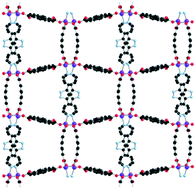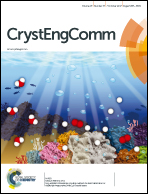The impact of N,N′-ditopic ligand length and geometry on the structures of zinc-based mixed-linker metal–organic frameworks†
Abstract
Combining Zn(NO3)2·6H2O with a series of dicarboxylic acids in the presence of the N,N′-ditopic ligand di(4-pyridyl)-1H-pyrazole (Hdpp) results in a series of mixed-linker metal–organic frameworks (MOFs) that have been crystallographically characterised. The reaction with 1,4-benzenedicarboxylic acid (H2bdc) gives [Zn2(bdc)2(Hdpp)2]·2DMF 1, which shows Zn2(μ-carboxylate)2(carboxylate)2 secondary building units (SBUs) linked by bdc ligands into sheets, and these are pillared by the Hdpp linkers into a doubly-interpenetrated three-dimensional network. The reaction with 1,4-naphthalene dicarboxylic acid (H2ndc-1,4) gives two products: [Zn2(1,4-ndc)2(Hdpp)]·4DMF 2a forms a three-dimensional network in which sheets, formed from Zn2(carboxylate)4 ‘paddle-wheel’ SBUs being linked by 1,4-ndc, are connected together by Hdpp pillars, whereas [Zn(1,4-ndc)(Hdpp)]·DMF 2b forms a fourfold interpenetrated structure based on diamondoid networks with single zinc centres as nodes. The reaction with 1,3-benzenedicarboxylic acid (H2mbdc) produces [Zn(mbdc)(Hdpp)]·DMF 3, which forms a two-dimensional network with (4,4) topology in which ZnO2N2 nodes are interlinked by mbdc and Hdpp linkers. The reaction with 5-methyl-1,3-benzenedicarboxylic acid (H2mbdc-Me) also forms a two-dimensional network structure, [Zn2(mbdc-Me)2(Hdpp)2]·DMF 4, albeit wherein dicarboxylates bridge between zinc-dicarboxylate tapes, themselves formed by interlinking of Zn2(μ-carboxylate)2(carboxylate)2 SBUs similar to those in 1. Finally, the reaction with 2,6-naphthalene dicarboxylic acid (H2ndc-2,6) yields two crystalline species, both having the formula [Zn2(2,6-ndc)2(Hdpp)]·DMF 5a/5b and possessing infinite zinc-carboxylate chain motifs interlinked by both naphthalene rings and Hdpp linkers into a three-dimensional framework. In compounds 1, 2b, 3 and 4, the pyrazole NH groups are involved in hydrogen bonding that serves to link either interpenetrated networks or neighbouring sheets together. However, in 2a and 5a/5b the NH groups project into the pores of the framework enabling interactions with guest molecules.



 Please wait while we load your content...
Please wait while we load your content...